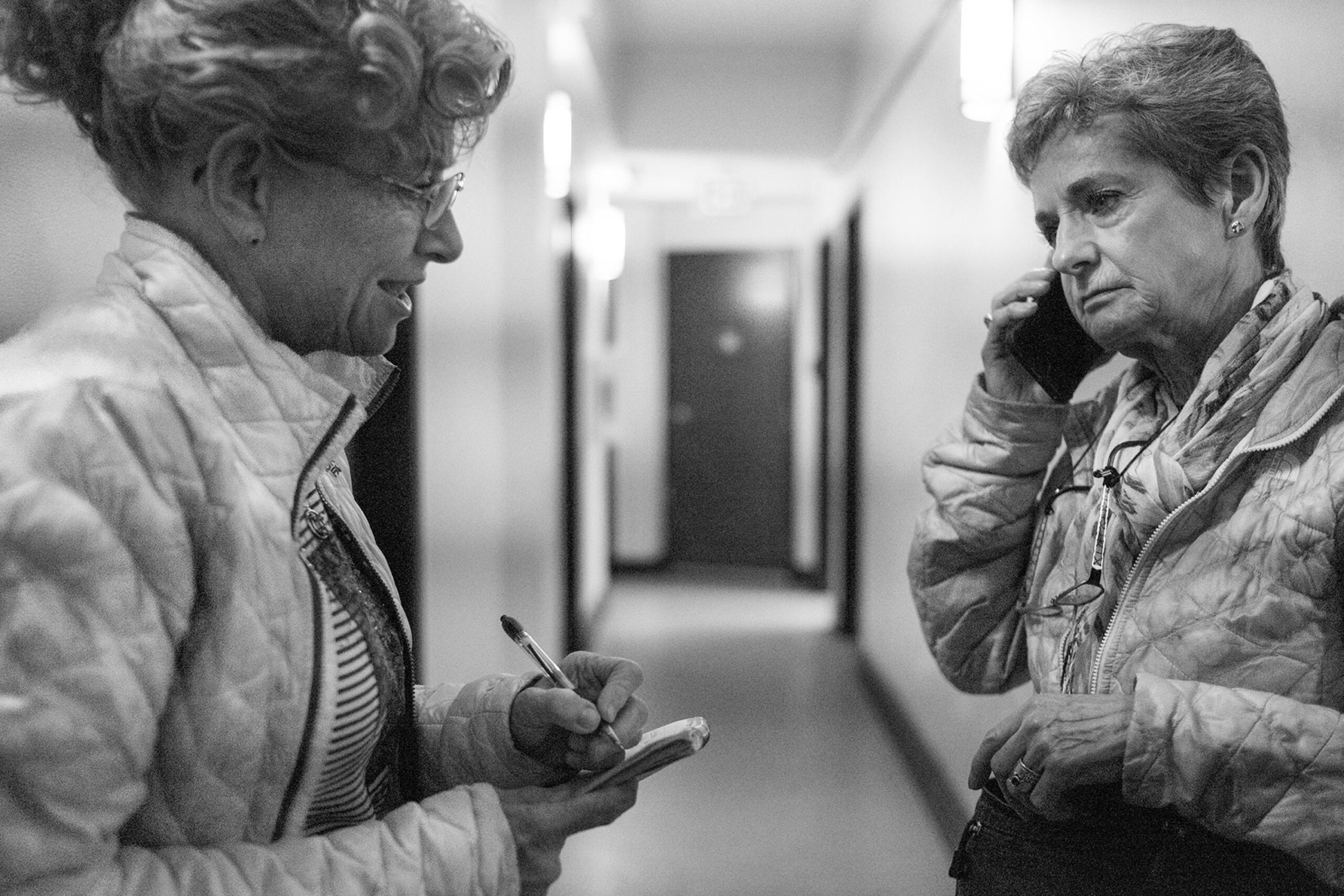It is a wet, miserable spring day in Vancouver, with lashings of cold rain turning gutters into creeks. The clock nudges 9 a.m., but outreach nurses Evanna Brennan and Susan Giles have been up for hours, either hitting the gym or going for a brisk walk before stopping to buy buttery croissants and fill their travel mugs with coffee, which they sip through a straw. “Otherwise I’d spill it on myself,” jokes Brennan, wearing a white blouse that would, indeed, show the slightest splatter.
Seated behind the broad desk in their office, located in the Jim Green Residence building on Alexander Street, Giles and Brennan discuss the day’s rounds at apartments, shelters and single-room occupancy (SRO) hotels in the Downtown Eastside.
You may unsubscribe from any of our newsletters at any time.
Nestled between the Vancouver Harbour, Chinatown, gentrified Gastown and the historic neighbourhood of Strathcona, the Downtown Eastside is home to about 20,000 souls, according to the 2016 census. Often referred to as one of Canada’s poorest postal codes, the area deals with drug addiction, mental illness and sex work. Tragically, some residents experience co-morbidities that include HIV-AIDS, diabetes, liver disease and hepatitis C. More than 1,000 people are homeless, some sleeping under the eaves of buildings or in makeshift tents of blue tarpaulin.
The Downtown Eastside also happens to be Brennan and Giles’s beat. At age 71 and 65 respectively, the pair — who are both married, with children or stepchildren and grandkids — embrace their unconventional work. Two years ago, as the principals of Action Based Care Nursing Consultants, they took on a full-time three-year contract with Lookout Housing and Health Society, a charity that provides residency and support services to low- and no-income individuals in the lower mainland of British Columbia. Nothing about the gig turned out to be straightforward, however. Just as they were hitting the streets, the opioid crisis exploded.

The nurses’ first stop of the day is the Walton Hotel SRO building on East Hastings Street to visit Rick, 54, a former Ontarian. Following back surgery to relieve sciatica pain, he was given the narcotic painkiller oxycodone, sold under the trade name Percocet. It was bewitching. “I fell in love with Percocet,” the former restaurant worker says.
The addiction drove Rick into the arms of heroin once the prescription ran out, and he eventually found that he needed a fix simply to feel normal. “People would say, ‘Oh, it’s sunny outside.’ Only if you take the drug can you see the sunshine, too.” Sixteen years ago, he came to Vancouver. “People move here because of the overwhelming supply of drugs,” says Rick, whose dealer is a convenient one-and-a-half blocks from the Walton. With fentanyl in the heroin pipeline, Rick knows he is playing Russian roulette with his life every time he shoots up. So far, he’s been lucky.
What he hasn’t managed to avoid is venous sclerosis, a loss of vein function that can lead to skin infections and abscesses. Years of IV drug use caused venous sclerosis to develop in Rick’s limbs, especially his legs, resulting in chronic ulcers. It is these wounds that Brennan and Giles are treating today — something they’ve done three times a week for more than a year.
Dressed in jeans and a hoodie, with thick black-frame glasses and closely shorn, brown hair, Rick ambles down the brightly lit hallway to where the nurses are preparing to change his bandages. The room serves as both a nursing station and a “safe-consumption” site — one of several places in the Downtown Eastside that monitor people during and after drug injection to prevent overdose deaths. The sites are part of a complex harm-reduction strategy that is continually being finessed as the opioid crisis continues its deadly swathe.
Giles, her delicate, red curls pulled into a ponytail, and Brennan, grey-haired, with large, expressive eyes, spend about 20 minutes with each patient. They must be quick and efficient to complete a schedule of visits that can run as high as eight to 10 people a day.
Rick knows the drill: he plunks himself in a plastic chair and rolls up the legs of his jeans. Brennan snaps on a pair of blue medical gloves and unwraps the ankle-to-knee bandages. Beneath the dressings, ulcers cover the front of Rick’s legs, extending laterally to the calf muscle. Brennan is happy, pointing out the healthy pink flesh around the perimeter, indicating healing. These ulcers have become significantly smaller since the nurses began treatment. Before, Rick says, he would be mortified to get on a bus, his jeans stuck to his legs with pus. “People would be looking around, and you could tell they were thinking, ‘What’s that smell?’”
WARNING: The following photo is graphic and may be upsetting to some readers.

Brennan soaks the wounds with gauze dampened with diluted vinegar and follows that with an iodine solution to kill bacteria and promote healing. Using a “no-touch” technique with forceps, she firmly rebandages Rick’s legs, enabling him to walk around comfortably and go to work at his construction job. It is imperative that the infection be kept under control to prevent it from turning into deadly septicemia or leaching into the bones, causing osteomyelitis.
Rick says he might not be alive today if it wasn’t for Brennan and Giles. “It’s not hard to see that they love their job,” says Rick, who previously struggled to go consistently to medical clinics for treatment.
As part of the slow march toward health, he obtains methadone — another important cog in harm-reduction strategies — from the Walton. Methadone treats opioid addiction by preventing withdrawal symptoms. Since starting the therapy four years ago, Rick estimates that his street-drug intake has dropped by about 80 percent. He is still driven to buy illicit drugs, but he is more careful now when he injects, selecting veins in his hands or upper legs. He talks about kicking his addiction, horrified at the number of friends and acquaintances who have overdosed due to fentanyl in the heroin supply. “The big guys on top making money — they’re killing us all off,” he says.
After visiting Rick and attending to another Walton Hotel resident named Gary, a slender man with a moustache who burned himself on a kettle, the nurses jump into Brennan’s four-door silver Volkswagen Golf, which is parked on the street. They manoeuvre through traffic congestion to a highrise called First Place, located just outside the Downtown Eastside. After ducking into a parking spot, the pair almost sprints, umbrellas held high, medical bags in hand, to the 129-unit residence, opened in 2012 to house adults with a history of homelessness.
The next patient is Jean-Marc, who, like Rick, has ulcerated legs from injecting drugs. Unlike Rick, however, Jean-Marc is in severe pain, his legs so swollen that the bandages became too tight, forcing him to unwrap them himself. As he slowly rolls up his pyjama legs, the nurses note a huge abscess behind his left knee and snap a photo of it with an iPhone to send to Dr. Susan Burgess, who has been a palliative care physician in the Downtown Eastside since the mid-1990s.
Similar to Brennan and Giles, Burgess visits some of her patients wherever they reside, shouldering a 10-kilogram backpack filled with everything she needs for ministering to the gravely ill, giving them her cellphone number so they can call any time, day or night. Giles and Brennan are Burgess’s eyes and ears: they alert her to potentially urgent issues, such as Jean-Marc’s growing abscess or a patient who needs antibiotics or an emergency prescription for painkillers.
Brennan and Giles are especially gentle with Jean-Marc’s wounds. Seated in a brown reclining chair, he grimaces with pain as they begin treatment. To distract himself, the former Alberta oil-field worker displays a small Narcan kit with a white cross, just big enough to hold needles and three ampoules of naloxone, the life-saving antidote to opioid overdose. It will counteract even carfentanil — a chemical cousin of fentanyl that is 100 times more toxic — although Brennan says five ampoules are sometimes needed to bring someone back from near death. (Opioids create euphoria but depress the respiratory system.)

Jean-Marc estimates that he has saved 30 people in his building and nearby back alleys in the past few years thanks to the kit. “Sometimes you’d find out later they wanted to overdose. Some people will OD more than once in a day — that’s a reason why the paramedics are so burned out.” (This past April, CBC debuted the documentary After the Sirens, which investigated the high rate — estimated at one in four — of post-traumatic stress disorder over the careers of paramedics, focusing on one working in the Downtown Eastside.)
Jean-Marc, too, finds himself fighting burnout. “All the grief and anger you carry around builds up.” He keeps a Bible by his chair and rosary beads on the other side of the tiny apartment and credits his belief in Jesus Christ for giving him an anchor in his chaotic life. At one point, Jean-Marc says, he asked “the Lord to either come and get me or come and save me.”
What keeps Brennan and Giles going despite the potential burnout? For Giles, it is resolve, experience and the strength of belief that “health care is everybody’s right.” There is also the knowledge that they are keeping the lid on another possible HIV outbreak. To their dismay, a few of their younger patients have gone off their antiretroviral drugs and are now developing opportunistic infections that put them at risk of developing full-blown AIDS.
After visiting Jean-Marc, the nurses unexpectedly meet Heather, another of their patients, at the elevator. The tall Indigenous woman first came to Vancouver as a young teen to look for her mother, who had left their northern British Columbia home. They reconnected, but her mother eventually succumbed to an AIDS-related disease. Brennan and Giles had just learned that Heather’s 22-year-old daughter died a few days earlier of an overdose. The two nurses quickly move to Heather’s side and hug her. “Is there anything we can do?” they ask sympathetically, their faces full of concern. “If you need something, just let us know.” The three converse in low voices for a few minutes. Heather remains sombre, and she takes the next elevator car down. “She has seen nothing but tragedy in her life,” Brennan says.

Giles and Brennan both started their nursing careers in 1979 with the City of Vancouver Health Department’s Home Care Program. Their jobs later shifted to Vancouver Coastal Health, from where they officially retired in 2012 before reinventing themselves as nursing consultants.
They first paired up in the 1990s, not only for efficiency of care but also for safety as they made their way around the Downtown Eastside. Their nursing skills were put to the test when Vancouver’s AIDS crisis peaked in the mid-1990s. Hundreds of people a year in British Columbia — many of them in the Downtown Eastside — developed the condition, the result of a virus that destroys the body’s immune system. During those dark years, HIV had spread like wildfire in the city’s gay community and among its intravenous drug users.
Before therapies like highly active antiretroviral therapy (HAART) became standard HIV treatment, conditions like cancers, tuberculosis and pneumonia devastated people’s bodies. Giles and Brennan — “street nurses,” as they were sometimes called — provided palliative treatment in the homes of patients.
Vancouver’s Dr. Julio Montaner, director of the British Columbia Centre for Excellence in HIV-AIDS, who is world-renowned for his work on HAART and other innovative HIV-AIDS treatments, recalls the work that Giles and Brennan did to help the dying. “Their compassion, caring and dedication in the Downtown Eastside in the early days of the epidemic — it was something that I never stopped admiring.”
Real compassion, say Giles and Brennan, encompasses much more than bandage changes and administering medications. It embraces, says Brennan, “relational” nursing, a sophisticated approach that incorporates harm-reduction principles within the framework of an individual’s living environment. This may mean that a nurse delivers care to a client living in a tent under a bridge.
Relational nursing is intuitive, holistic and, most importantly, non-judgmental. Does the patient have enough to eat? Do they need a bath? Are they refusing to go to hospital because they are worried about their cat? Would offering a chocolate, a cigarette or even a beer help them agree to have their hair cut or their nails trimmed?

Despite the dramatic success of antiretroviral medications, HIV-AIDS is a spectre lurking restlessly in the background. The factors leading to a possible resurgence currently exist in the Downtown Eastside. “For every single person living with HIV, if their treatment falls apart because of social issues, co-morbidity issues or intox- ication-related issues, those people are at high likelihood of complications related to HIV-AIDS,” says Montaner. “So remaining vigilant is the only way to go. If we don’t pay attention and [we] start looking the other way, HIV and AIDS can get out of control very quickly.”
Dr. Burgess also senses that things are possibly spiralling out of hand. She says most of the drugs that people are buying are laced with fentanyl or crystal methamphetamine, which induces psychosis and dementia. “These drugs have a terrible impact on the way that people think; there is a huge amount of psychosis and paranoia. These cocktails of drugs are not easily managed with our usual interventions.”
This means that Brennan and Giles are fighting a two-pronged battle: treating patients while maintaining a sense of optimism. Today’s situation reminds Giles of nursing in the 1990s before antiretrovirals. “People were dying horrible deaths. There was no end in sight.” As the current opioid crisis continues to take victims — 1,210 overdose deaths in British Columbia in 2017, with 2018 promising to match that statistic, according to the BC Coroners Service — Giles is feeling a grim sense of déjà vu. “I feel very hopeless right now. The overdose rate — it’s crazy.”
If Giles’s endurance stems from a steadfast belief in the universality of health care, Brennan’s arises from the reserves of strength nurtured by a devout religious upbringing in Ireland under the tutelage of Dominican nuns. This ethic was reinforced when Brennan was accepted into the prestigious Saint Vincent’s University Hospital in Dublin, where “the nuns ran the show. You had the name of the Father and the Son and the Holy Ghost in morning prayers — it was a huge part of nursing.” Today, Brennan, who survived a bout of cancer two years ago, finds herself falling back on her early training, praying for her charges in the Downtown Eastside.
The greatest panacea against burnout and world-weariness, however, is the strength that Brennan and Giles get from each other — and the people they care for. The nurses play off one another, bantering with their patients as a way of lightening the seriousness of their work while showing, Brennan says, “genuine interest in their lives, asking where they come from, connecting with them by talking about their children.” And, when a patient dies — often too early, in what should be the prime of their life — Giles and Brennan always attend the funeral or memorial service.
What Brennan and Giles accomplish can only be done as a pair. “We come as a package and have done so for years,” says Brennan. “We are like four hands on a piano” — a piano surrounded by a full orchestra of front-line workers trying to control an epidemic rooted in callous criminality. Similar to their work in the HIV-AIDS crisis, all Brennan and Giles can do is offer the best health care possible along with emotional support and, most importantly, love.
This feature was paid for through the David Wilson Observer Fellowship, a reader-supported fund that honours The Observer‘s former editor and supports high-calibre journalism. You can make a donation here!
This piece first appeared in the July/August issue under the headline “Angels on call.”















